Next 5 edition: 29th november to 1st december 2013 | Español

![]() JAPAN MEDIA ARTS
JAPAN MEDIA ARTS
![]() FESTIVAL
FESTIVAL
![]()
![]() ARS ELECTRONICA
ARS ELECTRONICA
![]()
![]() ART FUTURA
ART FUTURA
![]()
![]() MUNDOS DIGITALES
MUNDOS DIGITALES
![]()
![]() STREAMING MUSEUM
STREAMING MUSEUM
![]() New York
New York
![]()
![]() CINEWEST. Sydney
CINEWEST. Sydney
![]()
![]() CYBERFEST.
CYBERFEST.
Saint Petersburg
![]()
![]() CINEMATOU. Geneva
CINEMATOU. Geneva
![]()
![]() DSAF. Slovenia
DSAF. Slovenia
![]()
![]() MILANO Film Festival
MILANO Film Festival
![]()
![]() ANIMAFEST. Zagreb
ANIMAFEST. Zagreb
![]()
![]() ATHENSVideoFestival
ATHENSVideoFestival
![]()
![]() KIMUAK
KIMUAK
![]()
![]() AV:IN. Moscow
AV:IN. Moscow
![]()
![]() VIDEOHOLICA. Bulgaria
VIDEOHOLICA. Bulgaria
![]()
![]() IMF Cyprus
IMF Cyprus
![]()
![]() MIDEN
MIDEN
![]()
![]() GAME On! Videogames
GAME On! Videogames
![]()
![]() El MUR. Berlin
El MUR. Berlin
![]()
![]() MediaDOME.
MediaDOME.
![]() Serious Game
Serious Game
![]()
![]() DIGITAL LANDSCAPE
DIGITAL LANDSCAPE
![]() & Program Curators
& Program Curators
![]() - Screen MIAMI
- Screen MIAMI ![]()
![]() - Time is LOVE
- Time is LOVE
![]()
![]() Made in CANARIAS
Made in CANARIAS
![]()
![]() DIGITAL IMAGE
DIGITAL IMAGE
![]() Videoart
Videoart
![]() Videodance
Videodance
![]() Shortfilm/Film/3D
Shortfilm/Film/3D
![]() Web Film
Web Film
![]() Animation
Animation
![]()
![]() Art Science Innovation
Art Science Innovation
![]() Artificial life
Artificial life
![]() Software art
Software art
![]() Trangenic art
Trangenic art
![]() Generative art
Generative art
![]() Bioart
Bioart
![]() Nanotechnology
Nanotechnology
![]() Geospatial storytelling
Geospatial storytelling
![]() Videogames
Videogames
![]() Robotic
Robotic
![]() Free Software
Free Software
![]() 2D & 3D Animation
2D & 3D Animation
![]() Net-art
Net-art
![]() Digital Communities
Digital Communities
![]() Social Networks
Social Networks
![]() Blog, videoblog
Blog, videoblog
![]() Apps development
Apps development
![]() Mobil platforms
Mobil platforms
![]() Data Visualization
Data Visualization
![]() Mapping
Mapping
![]() Telesharing actions
Telesharing actions
![]() Telepresence
Telepresence
![]()
![]() about us
about us
![]()
![]() sponsors
sponsors
![]() & collaborators
& collaborators
![]()
![]() program
program
![]()
![]() venue´s photos
venue´s photos
![]()
![]()
![]()
![]() event 2009
event 2009
![]()
![]() event 2010
event 2010
![]()
![]() event 2011
event 2011
![]()
![]() event 2012
event 2012
![]()
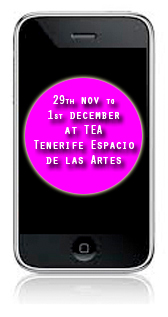
- Artificial Life
- Software art
- Transgenic art
- Generative art
- Bioart
- Nanotechnology
- Geospatial storytelling
- Videogames
- Robotic
- Free Software
- 2D & 3D Animation
- Net-art
- Digital Communities
- Social networks
- Blog, videoblog
- Apps development
- Mobil platforms
- Data Visualization
- Mapping
- Telesharing actions
- Telepresence
 International Call 2013
International Call 2013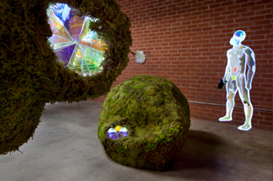
USA
http://www.mirichais.com/
Project: Augmented Garden
Miri Chais is a multimedia artist, often creating site-specific installations, dealing with technology’s impact on contemporary life, and massively connected to Japanese mythology and popular culture.
For her latest installation, AUGMENTED GARDEN, Chais has been influenced by Japanese Zen gardening, along with the idea of the Rabbit Hole from Alice in Wonderland. The Zen garden and the hole/tunnel, both concrete yet imaginary and symbolic places, share the qualities of neither being natural nor completely artificial places.
Two amorphic sculptures, which are reminiscent of Henry Moore’s reclining figures, have been covered with moss and embodied with kaleidoscopic prisms, encompassing American landscapes into intimate, fragmented and mirrored picturesque capsules.
A decapitated female body dressed in a yellow luminescent gown, chaperoned by hearted skulls and angels, is hung from the high ceiling, floating in the air. Its margins are colored in red, as if standing on the luxurious red carpet, or drenched in fame’s bloody tag price.
Chais’s use of LED lights lures the viewers by the beauty of the glowing sculptures which always retain, however, an underlying sense of cultural or geographical catastrophe, fear of loss and grief.
tag: artificial life
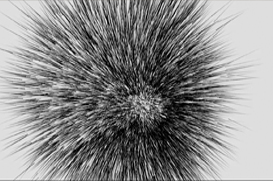
Quito. Ecuador
http://vimeo.com/livmusica
Project: Nebula Hmlovina
"An algorithm, a shape moving constantly across time, an automaton system that follows norms without questioning them, an infinite net of possibilities – like a chess game played by machines – derives in unimaginable substances, abstract characters, micro-worlds that emerge from the most ambiguous formulas and ideas and fragments. Creates figures that hatch indistinctively over a pixel’s canvas and make themselves space embracing it, generating a concept of artificial life, casting organisms subjugated under a geometric and abstract thought.”
NEBULA HMLOVINA is a work from ~Liv is the audio-visual Project of Pablo Rosero; composer, performer, visual and sound artist. Pablo Rosero’s work involves different artistic means. His work pieces have taken form from a sound-musical thought, which had been experienced a posteriori a transfiguration and adaptation to a visual realm. The artistic creations flow into multiple formats (graphic/digital arts, installations, performance, field recordings, control surfaces, sound-visual design, movement sensors and composition).
tag: generative art
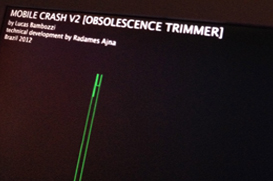
Sao Paulo. Brazil
www.lucasbambozzi.net
https://vimeo.com/bamba
Project: Das coisas quebradas
Mobile Crash v2 shows communication devices and equipments in state of obsolescence being continuously smashed by hammers. A computer algorithm picks the video sequences among the hundreds of short clips available. The rhythmic rate of the clips being played would vary according to sensors measuring electromagnetic fields in the environment, such as mobile phone calls or other signal operating at certain frequencies in the same range.
Such invisible signals would be the sources for leading the inputs, triggering the system to progressively display the sound and visual sequences in a mash-up style, which can be experienced in real time by the audience.
The installation aims to produce an ironic comment about obsolescence issues on the use of technological trends, as the more we consume and use them, the more it renders obsolescence.
tag: generative arts, software art
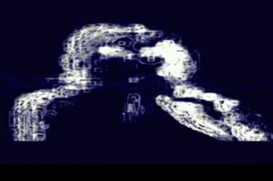
Hartford. USA
www.balam.us
Project: Pixel Aesthetics - self-portrait
Custom software developed by the artist. This video analyzes the aesthetics of pixels and the relationship with human and technology the sounds are generate by computation analysis of pixels and motion.
tag: software art

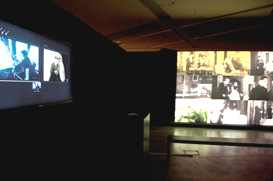
Hong Kong. Hong Kong SAR
http://concept-script.com
Project: Gestus: Judex
The Gestus project exists as an interactive application and video installation about images, surveillance technologies, and the visibility of movement and gesture. It is a custom software that analyzes the movement in one or more movies. It then finds clips that contain similar movements and displays them side by side, inviting the audience to focus on motion as an end in itself.
The current video database contains shots from Louis Feuillade's 1916 film Judex. The software processes this material into a 9-image grid, where the movie runs from beginning to end in the center of the screen, while 8 shots (from the same film) whose movements most closely match those in the current shot are arranged around it.
Whereas mainstream cinema normally directs our attention towards people, objects, and events, Gestus encourages spectators to focus on movement. Sometimes the viewer has to recognize that two different objects, such as a person and a river, or a dog and a tree branch moving in the wind, are moving in the same way. Gestus opens up the domain of micro-movement, guiding attention on the tiny motion of an eyelash or a finger. It cues the spectator to engage in an active process of visual thinking, comparing the various images in an effort to identify the similarities between them.
Sometimes, the viewer easily detects similarities but in other cases the movements are very subtle and occur in different areas of a crowded image, posing a sharper perceptual challenge. Perhaps a dropping hand near the bottom of one image corresponds to a leaning shoulder near the left edge of another. The viewer's gaze becomes restless as it scans simultaneous
images, attempting to identify analogous movements. The system invites, challenges, and sometimes frustrates the spectator's cognitive-perceptual skills.
For a more comprehensive description, please refer to the project's website: http://www.concept-script.com/gestus/index.html
tag: software art

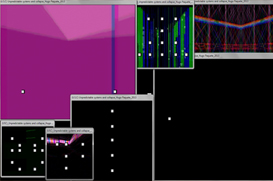
Portugal
http://www.youtube.com/watch?v=0HkXr1-OpzU
http://about.me/hugo.paquete
Project: [USC][Unpredictable systems and collapse]
This software its part of a Meta-media performance that explore the interaction of sound, image and performative experiences over the concept of Glitch and the general accident of failing.
The factor of transformation, glitch and transitivity against predictability was taken into consideration to generate this software.
Accumulation effects crash over the system generating an entropy disorder to achieve the failure over a general accident. Over the operative system represented as a counter paradigm of order and functionality.
Over imposing a abstract language of colours and shapes base in the virtual environment of the operative system. Saturating the space with sound in till the collapse of the machine.
Exploring the post-digital condition of approach the machine and code as a mechanism / language with limits to explore in the error level. As a new aesthetic formulation in a world of supra performativety and order.
A system generated to fail in a poetic allegory over the infinity of formulas.
Based on the concepts of regularity, irregularity and functionality, this chance proposal was built taking into account factors such as the relationship construction of a machine, tool and non-linearity, abstraction, because there follows a linearity assumption of control, being casual and relative in origin. I would like to underline a passage from the book: Samuel Beckett and Abstract Machines Deleuze and Guattari Philosophy after. The Abstract Machine, on this model, is a phylum, comprising 'particles' of 'matter' which cannot be converted without remainder into form, an 'inorganic vitality' which by definition is opposed, and resistant, to an organic composite formation. In this sense it is virtual rather than current, rather than real realized. The Abstract Machine is not static like the 'deep structure', regarded as a Given, Which on structuralism is predicated, but is, rather, Involved in constant variation, in perpetuum mobile. It’s propulsive force. However, it is not susceptible to being gridded by reference to an evolutionary or teleological template.
This factor of transformation, mutation and against structuralism was taken into account in a software construction and performance, as the attempt by accumulation effect to crash a system, or the manifestation of its construction by accumulation and entropy as order to prove their strength and vitality. This force of vitality system, machine, and mechanism of action, dynamic performative imposition of a system can be regarded as a representation of the infinite quest within an operating system or its limitation. This concept also limits this programmatic intentions expressed in the performance. Because it opens its length up to the point where the system becomes saturated and fails, this being the point of allegoric or poetic search for infinity. Infinity is not a number, not an object, not a formula.
tag: software art

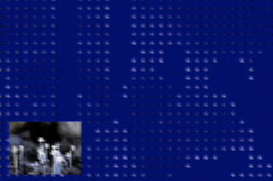
New York. USA
http://pump.org.in/
Project: Creating the Self
Transgenic art [technically, this would be "transontoligic art," not strictly mimicking genes or phylogeny. However, distinguishing between "nature and "nurture" is no longer meaningful. Evolution and development are intertwined].
This interactive computer piece both displays the graphic animation, and broadcasts the sonic complex waveforms. The piece is not an art object to be observed passively from a distance, but is Behavioral Art, where the "artwork" is in what individuals do in the space. In this case, the individual's presence is integrated into a mechanized world. All worlds, in becoming landscapes, must be understood relatively by the inhabitant.
In an empty landscape (gallery space), the monitor is dark, and all is silent. Audience members enter a camera is used to detect motion. This information is translated into both animation and sounds. As one begins to recognize the correspondences between the individuals intentional gestural experimentation, changes on the screen, and audible changes, the audience member learns to interpret "signal noise" as landscape.
This artificial computer environment is a simplification of the process we undergo extensively during childhood development, but continues to be fine-tuned until death. The learning process, coming to distinguish chaos from intelligent organization, is an instinctual strategy the brain relies on, that augments what cannot be predicted about our needs by genes, can be simply called "art."
tag: transgenicart

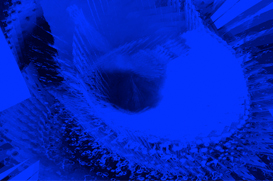
Project: Digital Synthetic II
"Digital Synthetic II" is the second in Copps' "Digital Synthetic" series, the first of which has shown in galleries and museums including the Smithsonian Institute in Washington, DC. A generative audio/video piece, "Digital Synthetic II" uses a SONAR sensor and advanced coding to detect both the presence of a viewer and their distance away from the piece. The piece then reacts, using the position of the video pixels to paint a unique video painting for each viewer based on the moment they stepped in front of the piece and their distance from it. The audio is manipulated simultaneously in much the same way.
"Digital Synthetic II" does not only respond to the viewer at that moment; each user's presence also alters the course of the piece. This bilateral exchange affects both the viewer and the piece, challenging the traditional notions of spectatorship and one-sided interactivity.
tag: softwareart

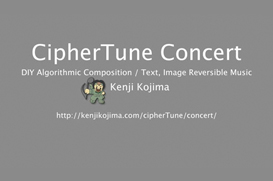
New York. USA
http://kenjikojima.com/cipherTune/
Project: CipherTune
Every 21st century civilian should have encryption technologies, even an artist and art works. The software art "CipherTune" is an encrypted image is converted into a music. The music can be decrypted to an image.
"CipherTune Concert" is an interdisciplinary art. The art works are reversible algorithmic compositions of ciphered images on the Web (http://kenjikojima.com/cipherTune/concert/). The project is experimenting with the relationships between perception, cognition and digital technology, cipher, visual art and music. There were 10 music files and a downloadable software "CipherTune" which were created and programmed by the artist. The music composing method was combined with an algorithmic composition and a cipher technology that used Blowfish 256 bits. Blowfish was one of strong cipher algorithms. The program CipherTune encrypted a photo-data, then it converted to a MIDI music file. The music file could be decrypted to the original photograph by using CipherTune. If you download CipherTune, you can try to decrypt a music to the original photo.
Encrypted photo-data was text-data. All characters of computer text are mapped 0 to 255 numbers that known as ANSI. The program CipherTune read each character of encrypted photo-data and converted them to musical notes. It figured out 120 or 121 is the middle C, an even number was eighth note, and an odd number was sixteenth note. The converted notes were equivalent 128 keyboard music. The program CipherTune could choose a musical tempo and an instrument. A combination of different tempo and instrument made interesting effects of MIDI sounds. You might notice "The Great Lawn" which was the top of the music list that had a lot of photo-data but the duration was only 1:58. The tempo of the music was very fast, however the music was distorted and slow. However the sound effect depended on your computer condition. The musics were created by two algorithms that was automatic, and two musical elements that your could adjust a music to your favorite.
CipherTune was inspired by Alfred Hitchcock's movie "The Lady Vanishes". An old lady disappeared on a train when carried the secret encoded tune to the Foreign Office in London.
tag: softwareart

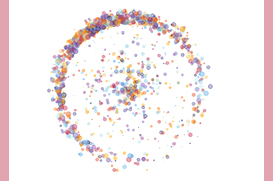
Munich. Germany
www.ivanbelchev.com
Project: Paloma
tag:generativeart

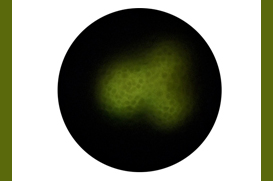
Project: Primordial
In its structure the cross-wired generative audiovisual work ‘primordial' refers to the organic flexibility and chaotic nature of a self-contained organism. All aspects of decision-making are thus improvised by the underlying system, and based on the complex feedback circuits flowing between its individual Microsystems. This creates an ongoing but ever changing self-similarity within its progression. Special emphasis is placed on the holistic unity of the work, combining image development and sonic change into one single symbiotic entity. The intricate cross influence of the mesmerising fluid movement in image and sound, together with the harsh synchresis of its sudden repositioning, portray a pluralistic state of mind, fluctuating between tranquility and tension.
tag: generativeart

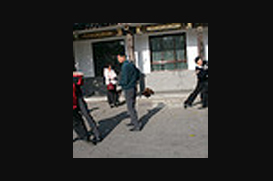
London. United Kingdom
www.cargocollective.com/D8A4RMScom
http://paper.li/ data4or ms/1372327920
http://www.flickr.com/people/ 9 1016541@N08/
http://d8a4rms.qpoe.com/ wordpress
Project: PhotoZone
Active project website-photos taken using a cell phone camera, quick snaps .reportage. Taken of public [with their consent] of people that in the photographers opinion look 'comfortable' that is they are 'comfortable' with themselves a comfort zone between the photographer and the subject.
The project is un-restricted by time barriers other than the duration of the project parameters [approx. 3 months]. Access to uploads via flickr [ google or equivalent s respective to the project software] is immediate via a simple mobile phone widget accessible on the project website - upload photos-bluetoooth and point and shoot !. The aim of the project is to create a multi-disciplinary location artwork and media event to stimulate open knowledge exchange and broaden access to open source media.+ The Gallery Project Assignment, gallery and studio space projects: using the gallery as a studio space showcasing artists work in progress: projecting the website on to the gallery space.focused on outreach workshop structure with the aim to stimulate open knowledge exchange and broaden access to open source media. Keywords PhotoZone multi-disciplinary interactive, trans-media, open source, location artwork, socio- and geo, transitory art screening of multi-disciplinary interactive installation, gallery workshop / event; media studio ‘movements'.
tag: generativeart

Malmö. Sweden
http://flickr.com/icolorama
http://appstore.com/icolorama
Project: iColorama App
IColorama am the developer of one of the best app for creating art on the iPad and iPhone
tag: softwareart
Buenos Aires. Argentina
http://polsick.bandcamp.com
http://vimeo.com/61401535
Project: Natural.Code
Natural. Code por Pablo Anglade y Gastón Luciani. Media Art basado en la fusion compleja de sonidos orgánicos y escenas visuales de codigo generativo, reaccionando a la complejidad timbrica de la Naturaleza Patagonica Argentina.
Natural. Pieza compuesta por Pablo Anglade. Creada utilizando fragmentos de grabaciones de paisajes sonoros del sur de la Patagonia Argentina. Estas grabaciones de campo fueron trabajadas y editadas como materiales sonoros y combinadas con elementos electrónicos. Inspirada en la organicidad y complejidad tímbrica de los sonidos de la naturaleza.
Code. Escenas visuales generativas compuestas por Gastón Luciani. Desarrolladas y diseñadas íntegramente bajo el entorno de programación visual por cajas, Quartz Composer.
tag: generativearts

Ciudad Autónoma de Buenos Aires. Argentina
www.joaquinfargas.com.ar
Project: Inmortalidad
Inmortalidad es una instalación bioartística en la que se intenta fusionar al hombre con la tecnología, lo artificial con lo natural, para superar uno de los límites más grandes que condiciona nuestra existencia: la muerte. Inmortalidad es un organismo artificial capaz de vivir eternamente. Compuesto por un tejido de células cardíacas, Inmortalidad late indefinidamente y nunca envejece. A través de sensores, este híbrido se conecta con el exterior, reacciona, late con más fuerza, modifica su ritmo cardíaco. La presencia del otro (el espectador) le da vida.
tag: transgenicart, bioart
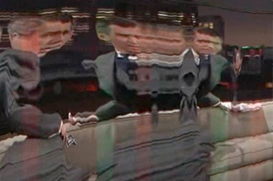
Wroclaw. Poland
http://www.joannabonder.com/rope
https://joannabonder.see.me/
Project: ROPE
This artwork is processed first color film by Alfred Hitchcock in 1948, where it was used the idea of the unity of time and place, while doing away with the "cut" scenes. I designed an algorythm which changes the visual layer of this movie. It gives me one sequence, a form reminiscent of the title line 13 centymetrów its size is at 40 meters (the time lenght of video material determines the width of final result). It can be viewed as both widescreen, so that within 50 seconds we get condensed into an abstract form video. Ultimately, however, the projection assumes a fragmented playing it to adjust the length of the projection to the original length of the film, creating a continuous loop, and by moving the longitudinal image. The project also envisages the possibility of presenting in print, it has been realized with automated drawing vertical slices, during the entire length of the film.
tag: generativearts
Wroclaw. Poland
http://www.joannabonder.com/numbers
https://joannabonder.see.me/
Project: Digits
tag: generativearts
Participatory Event Cartography is a generative visual art project that aims to create two-dimensional “maps” of the event in which the art work is located by utilizing digital public data referring to the event (twitter, facebook) and data that is gathered directly at the venue (wifi communication, audio data, movement data of participants). The maps themselves are created generatively, and thus at every time reflect all of the data from the beginning of the event until then. Main idea of the maps is to give an understanding of the dynamics and the underlying hidden infrastructures of the event in an easy-to-understand way, while they are indeed presenting patterns found in the data in a visual way. The participation of the user is derived from the data gathered from the venue and is manifested in the maps in real time.
Goal of the project is to generatively create these maps using techniques from computational biology and while these maps are created to learn the patterns behind the data of the event using statistical machine learning techniques in order to create a better understanding of the processes taking place at such an event and to be able to create a common metaphor (the map) to visually compare events in the future. Using ideas from computational biology, every map created can be seen as an evolving one, starting at the beginning of the event as a very basic and easy 2-dimensional canvas and developing over time and increasing in complexity as the event itself increases in complexity, number of attendants, number of talks given and artworks presented. The pattern recognition part of the art work gives will give us information that can later be used not only to visually, but also to computationally characterize and compare events with each other and thus creates an artistic framework for event modeling and characterization.
By such an approach, we intend to raise an awareness about (a), basic mechanisms providing a better understanding of today's technogene spaces, i.e., spaces which are not only generated by technical means but moreover, generated by the latter as a new kind of spatiality and thus, worlds having a 'reality' character in the same degrees as physical ones have; and (b), alongside with this, to reveal fundamental patterns of both recognition and world-perception which are so commonly used today that we don't even reflect about them, in just simply using them without considering what is standing behind, in terms of constructing 'the world' as well as perceiving it in its fundamental conditionalities. For both these aspects, we want to raise a greater awareness, because they embody the moulding forces of our recent reality.
tag: generativearts
Oviedo. Spain
Project: Singular Hypersurfaces
Whereas scaling invariance appears evident in many works based on fractals or tilings, in this works, which are related to singular algebraic surfaces, the scaling properties are hidden. They are based on arrangements of lines in the plane, some of them containing the prototiles of a series of selfsimilar deterministic and random substitution tilings. The resulting surfaces have many singularities, namely, points whose neigbourhoods are not topologically equivalent to flat disks. They are generated through an unexpected connection between two fields: the theory of substitution tilings and the classification of singular surfaces in algebraic geometry. However, it is not so much the process as the final result that characterises this works.
tag: generativearts
Caracas. Venezuela
www.virtualgallery.com/#!alexandra_masson_a509413/
alexandra_masson_eclectic_mix_s7100
www.saatchionline.com/profiles/index/id/247732
Project: Srta.
He creado un nuevo mundo de imágenes a través de fotos digitales manipuladas que representan una multiplicidad de encuentros y emociones, sugiriendo sueños, repetitividad e incertidumbre pero también encuentros de una naturaleza única y quién sabe, tal vez posible. Los fantasmas que los miembros de mi familia han visto, o las posibilidades de efectuar un viaje astral… una red expansiva de misterios involuntarios que existen en la vida. Mi interpretación se vuelve un reflejo de la realidad, de aquello que está oculto o no, de aquello que ha sido transformado y ya no se asemeja a lo que era originalmente, tal como el plan original que uno tiene para la vida de uno y el modo como las circunstancias externas influencian y modifican dicho plan, volviéndolo obsoleto a veces y completamente diferente de lo que uno esperaba ser y tener al final. Estas obras invitan a realizar un ejercicio de interpretación, reflexión e incluso de imaginación, donde en ocasiones se establece un diálogo entre el objeto y el sujeto. La potencialidad de un obra de arte existe en la medida en que representa un vehículo para hacer llegar un mensaje, en el cual cada elemento que posee está repleto de significancias y contiene la expresión de mi vida, reflejada en los caminos que he transitado, voluntariamente - o no.
tag: softwareart
Eindhoven. Netherlands
https://vimeo.com/petraenmario/videos/
Project: WAVES: Feedback guitars
WAVES Feedback Guitars" was part of the Sound Seeing Festival 2012 in Germany. In the Black Box of CUBA Kultur in Muenster we set up two guitars and tensed 2 long strings with shakers. Moving around the space influences the sounds that are being generated through this feedback setup
tag: generativeart, installation
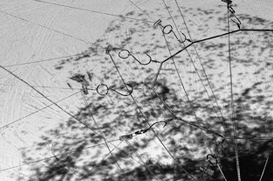
Pamplona. España
www.patxiaraujo.com
https://vimeo.com/53061986#
Project: Ehime Daruma
Ehime Daruma es un complejo interdependiente formado por elementos mecánicos, electrónicos y virtuales, por la significación de otras unidades descontextualizadas o a-tecnológicas (hilo, muelles, arandelas, anzuelos, discos de vinilo taladrados, un lecho de harina) y por el conjunto de relaciones que se establecen entre el público y ella misma en un entorno de luz y oscuridad en blanco y negro. Tomando como pretexto y punto de partida la leyenda del sabio Daruma, la obra pretende dar una lectura relevante a aspectos vinculados a la relación de las máquinas con su entorno; plantea el reto de la fusión de su propia naturaleza dual [real/virtual] en una sola, y aporta datos para el encuentro entre el humano y la máquina a través de su mutua observación en claves tecnológico poéticas. Desde un punto de vista más especulativo, y mediante la percepción que surge en ese peculiar encuentro meditativo humano-maquinal, invita a la reflexión acerca de la influencia del pensamiento sobre la materia.
Desde un umbral llamado tesitura de volatilidad [capaz de reflejar sus tensiones, decisiones y dudas] Ehime Daruma construye el lugar en donde confluyen las diferentes partes que concurren en la obra: lo físico-mecánico y lo virtual a través de un comportamiento que busca su propio espacio teniendo siempre en cuenta lo que ocurre en su entorno próximo.
Ehime Daruma crea conexiones consigo misma desarrollando un comportamiento público, extrovertido, y otro privado, de recogimiento. A través de la proyección del ser que habita su espacio y de su propio funcionamiento físico, bascula entre el estímulo exterior y su tendencia al ensimismamiento. Irremediablemente atraída hacia alguno de estos dos polos (como si de un castigo eterno se tratara), se busca en la presencia y en el movimiento del otro, o en su ausencia. A la vez, induce al espectador a actuar en función de los vínculos que establece con esa conducta, provocando el deseo de ver cómo se mueve, o de permanecer invisible junto a ella.
El hecho de ofrecer en el exterior de su propio entorno la imagen en el tiempo de las trayectorias que nosotros como público visitante describimos a su alrededor, nos incluye [desde la perspectiva de su percepción] como parte de una dinámica de partículas invisible para nosotros pero evidente para ella, relativizando nuestro papel protagonista y trasladando las preguntas que hemos formulado a nuestro propio comportamiento.
datostecnicos:Ehime Daruma es un entorno construido de elementos hardware, proyectivos y espaciales. Este entorno se divide en el espacio que ubica la pieza [1] y la propia obra [2].
1. El espacio que ubica al objeto Ehime Daruma es una black room conceptualmente próxima a una escenografía, un entorno de luz rodeado de oscuridad en donde conviven la obra, el público y las relaciones que se establecen entre ellos.
2. La pieza, que se haya compuesta a su vez por los siguientes sistemas interrelacionados:
A. Una estructura poligonal de aluminio de 12 lados, 4 metros de diámetro y 80 cm de altura, que delimita el espacio privado de Ehime Daruma. Este espacio está cubierto por una capa de harina a modo de orografía y pantalla, y se encuentra rodeado por un sistema electromecánico compuesto por controladoras, cables, hilos, motores, bobinas, sistemas de transmisión,… que dotan a la pieza de sus capacidades móviles.
B. Una estructura no escamoteada de tramoya hardware situada directamente sobre este espacio y que alberga los sistemas proyectivos de luz, sonido y video captura, compuesto por dos proyectores de 5K Lumen, dos megáfonos y una cámara de videovigilancia filtrada en su espectro infrarrojo.
C. El sistema informático gestor del análisis de los datos de la captura de video y de la posterior generación de algoritmos para el gobierno de los motores, la generación del sistema de partículas y el sonido.
D. La monitorización mediante una pantalla o proyección de las trayectorias del público inmerso en ese espacio como elemento deslocalizado del mismo y que es visible sólo desde el exterior.
tag: softwareart, generativearts, robotic
Project: I [undo] me [by] myself
sinopsis: Tomamos como base imágenes publicitarias, especialmente en las que la piel y el cuerpo son parte importante de la misma. Imágenes y cuerpos finalmente como ficciones creadas y asumidas de manera profunda y colectiva que desde nuestra posición nos permiten darles un nuevo espacio. Atravesamos el ámbito de lo diferente, de su modificación, reivindicamos la posibilidad.
Des-dibujamos las partes que muestran piel y al mismo tiempo, hemos creado un software que mediante vídeo recoge la acción y la traduce en otra imagen y en audio. Una nueva imagen, nueva representación que muestra una interpretación de los diferentes gestos y movimientos realizados al des-dibujar.
tag: generativearts
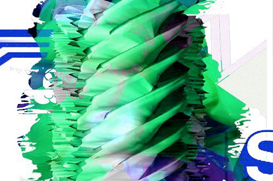
Nuremberg. Germany
http://gallery0nline.wordpress.com/zil/
https://vimeo.com/user8975984, http://zil-zil-zil.tumblr.com/
Project: | MEMOREX |
MEMOREX͢ by ZiL. The internet is a place in which feedbacks occur every second. A feedback is a process in which information about the past or the present influences the same phenomenon in the present or future
This is created within a certain relationship whereby the subject/object that delivers a stimulus to a second subject/object, will in response receive the stimulus back.
This first impulse is reflected back and forth over and over again. As part of a chain of cause-and-effect self-regulating mechanisms in internet glitch art works as new sociological concept and grows a corrupted digital feedback connection.
̶
MEMOREX is an abstract trip through feedback error encounters and further glitch development. Here the Link:
http://gallery0nline.wordpress.com/zil/
tag: generativearts
Silke Kuhar and Zoy Winterstein
Nuremberg. Germany
https://vimeo.com/user8975984
www.zoywinterstein.com
https://vimeo.com/31112507
https://vimeo.com/30287904
Project: Journey from Alpha to Delta
Journey from Alpha to Delta: Four Rooms are used for the audio-visual installation in which you hear four different dynamic and experimental sound collages by Zoy Winterstein and see four film collages made by ZIL (Silke Kuhar) and ZOY. Most material which is used is found material.
This installation gives the public an associative, multi-layered journey to intensify the synaesthetic perception to create an an individual, intensive experience. The visitor can decide freely and subjectively in which room he stays and can control the manner in which he gets involved with perceptual, affective and coincident processes.
tag: generativearts


